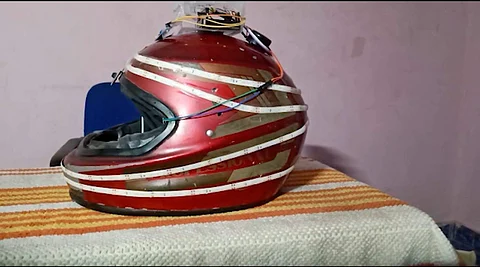

If you think wearing a helmet is just meant to save your life in case of an accident, then this smart helmet is all set to prove you wrong. Named the Brain Bucket, the helmet has been designed by students and faculty at Amrita Vishwa Vidyapeetham in Coimbatore. It does several things, right from tracking your heart rate to providing navigation while on the road. We spoke to the project mentor Dr Prashant R Nair, Associate Professor in Computer Science and Engineering and the Student Lead, Darshan Jain, about how the prototypes came to be developed. Excerpts:
1. Why a smart helmet? What was the motivation behind it?
Darshan: One major problem that we see nowadays on the road is that people do not actually follow traffic rules when they are riding or driving. Delivery personnel are always in a rush and they end up bypassing a lot of safety precautions. They are often on the phone due to them nature of the job. But there needs to be a smart solution for them that minimises the risk of riding on the road without creating a distraction for them. This is why we developed the smart helmet that has navigation features, hands-free calling and music, a virtual description of routes that the driver can take while riding and traffic signs and symbols that the driver needs to abide by.
Prashant: Today, the gig economy has expanded in a big way where we see delivery professionals en route to delivering all sorts of things to homes and businesses. That makes our innovation a much needed product for people.
2. Would it not intervene with the awareness that a person requires while riding?
Darshan: It is a very valid point of concern. We have been battling with this issue whenever we go for competitions with our product. The solution we have come up with is that we will be offering vocal and visual support only. The directions that will be voiced in the ears will not completely drown out the outside surrounding sounds. In terms of visual support, there will be LEDs somewhat below eye level to indicate that the rider is making a turn so that others are aware and the rider would themself find navigating easy.
3. What are some of the technologies that you have utilised for the smart helmet?
Darshan: We are using IoT and Machine Learning as well in our helmet. We have an accident alert system which signals the SOS contact in case of an emergency. There will also be a heart rate sensor. The IoT device will give information on the riding pattern, heart rate and the time frame in which one rides. Based on this, we can predict how good the rider is and how prone he is to accidents.
Prashant: It is basically analytics-based on which we study the patterns and make this data available to possible businesses like the ones that rent out vehicles. If a person is too accident prone, then they can be barred from using the service again.
4. With all the features that you have added onto the helmet, does the end product not become too complicated for a single user?
Prashant: The user will only be interacting with the navigational tools as well as the voice and visual support. All the other features will be running in the background for the safety of the rider.
5. What are some of the other features on the helmet?
Darshan: Moving forward, we have plans to implement a dash camera on the helmet. It would essentially record the entire video of you riding the vehicle. In case of accidents and incidents of road rage, the video can be used as proof for insurance or for police matters. We are currently in the process of compressing the video file into a manageable size so that we can store it on the device. Hopefully, we will be able to solve it soon.
6. Can you talk to me about the traffic signal detection system on the helmet?
Darshan: Many people do not care about signals like school zones, hospitals and no entry. With the smart helmet, it can detect these symbols and relay the information to the user in terms of vocal support. If the helmet detects that the user is not complying with these signals, there will be an alert sent to the concerned party who employs these users or to the traffic police itself.
7. So what is up next for your team?
Prashant: I think a big setback for us has been the pandemic. We have not been able to sit in a room and brainstorm ideas together. Hopefully, we get to do that once the COVID situation has subsided. Secondly, we are now in the phase where we would be required to do a lot of field testing of our equipment. This would ensure that our alert systems are accurate and do not go off in case of a false alert.
Darshan: Another hurdle that we managed to get over is the support that we required for the development of our product. A lot of the time, the mentality is set in stone for engineering students of the fact that they are supposed to get jobs after studying. But at our university, we have always been welcome to developing an entrepreneurial capacity and our mentor Dr Prashant has motivated us highly.
